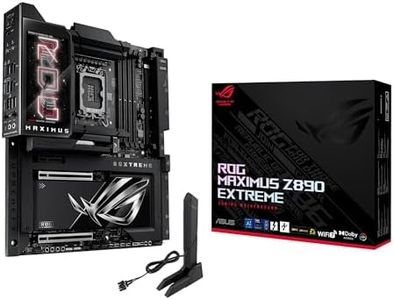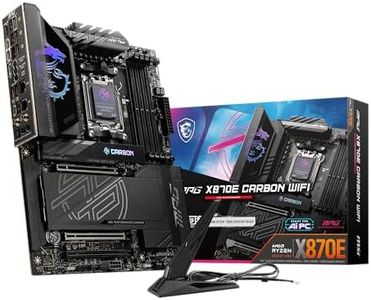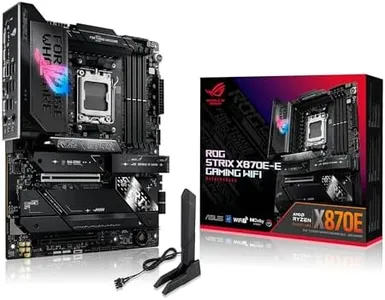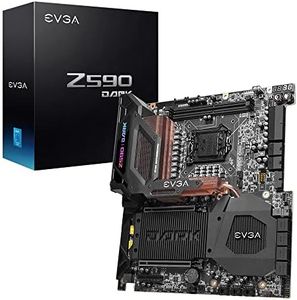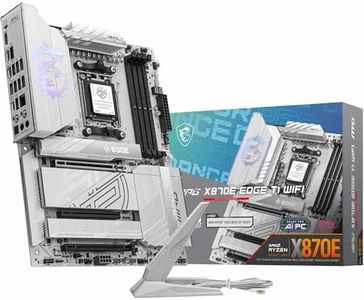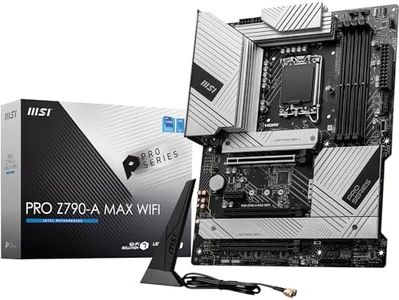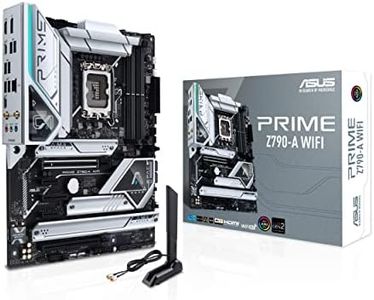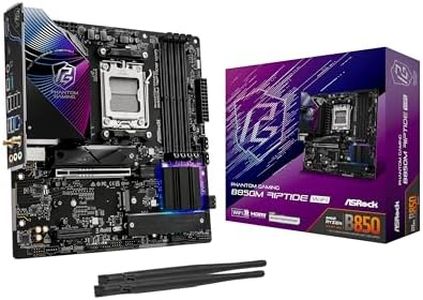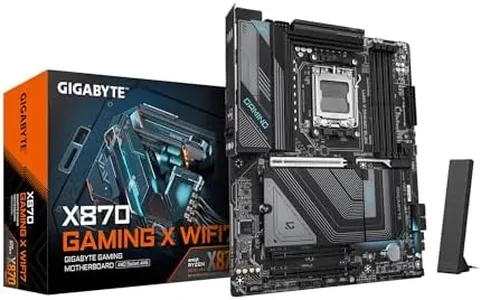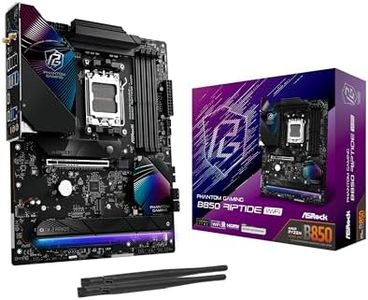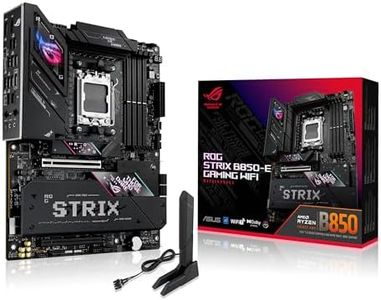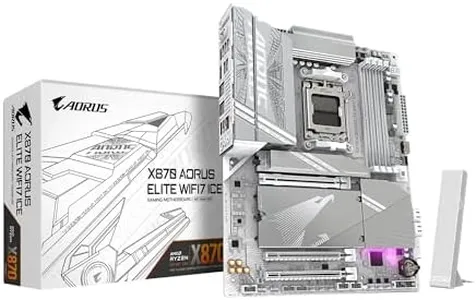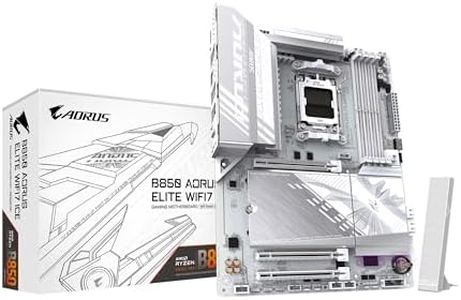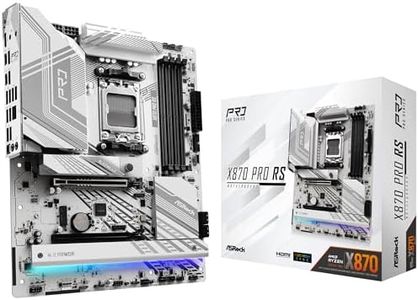10 Best Motherboards 2025 in the United States
Our technology thoroughly searches through the online shopping world, reviewing hundreds of sites. We then process and analyze this information, updating in real-time to bring you the latest top-rated products. This way, you always get the best and most current options available.

Our Top Picks
Winner
ASUS ROG MAXIMUS Z890 EXTREME Intel® Z890 LGA 1851 E-ATX motherboard, Advanced AI PC-ready, 24+2+1+2 stages, DDR5, WiFi7, 2.5G/10G LAN, PCIe® 5.0 M.2, Thunderbolt™ 5, USB Type-C®, AI OC, 5” LCD Screen
The ASUS ROG MAXIMUS Z890 EXTREME is an advanced E-ATX motherboard designed for high-performance and future AI applications. Featuring the Intel Z890 chipset and LGA 1851 socket, it supports the latest Intel Core Ultra Processors (series 2), making it suitable for demanding computing tasks. With DDR5 RAM slots and a robust power solution of 24+2+1+2 stages, it offers exceptional memory performance and stability, suitable for gamers and professionals alike.
The motherboard boasts extensive connectivity options, including WiFi 7, 10G Ethernet, dual Thunderbolt 5 ports, and multiple USB Type-C ports, ensuring fast and versatile data transfer capabilities. Storage options are ample, with support for three PCIe 5.0 M.2 slots and additional PCIe 4.0 M.2 slots, all equipped with significant cooling solutions to maintain optimal performance. The inclusion of advanced AI technologies like AI Overclocking, AI Cooling II, and AI Networking II simplifies setup and enhances system performance.
DIY enthusiasts will appreciate the user-friendly design features like Q-Release mechanisms, pre-mounted I/O shield, and clear CMOS button. However, its premium features and robust design come with a higher price point, and its E-ATX form factor might not fit in smaller cases. Weighing 11.77 pounds, it is relatively heavy compared to other motherboards. In conclusion, the ASUS ROG MAXIMUS Z890 EXTREME is a top-tier choice for users seeking cutting-edge performance, extensive connectivity, and advanced AI capabilities, though it may be overkill for casual users or those with budget constraints.
MSI MPG X870E Carbon WiFi Gaming Motherboard (AMD Ryzen 9000/8000/7000 Series Processors, AM5, DDR5, PCIe 5.0, M.2 Gen5, SATA 6Gb/s, USB 40Gbps, HDMI, Wi-Fi 7, Bluetooth 5.4, 5Gbps LAN, ATX)
Most important from
436 reviews
The MSI MPG X870E Carbon WiFi Gaming Motherboard is designed for gamers and high-performance enthusiasts, supporting AMD Ryzen 9000/8000/7000 series processors. It uses the Socket AM5 and AMD X870 chipset, ensuring compatibility with the latest CPUs. Its ATX form factor provides ample space for a variety of components and makes it suitable for standard gaming builds. With DDR5 RAM slots and a memory speed of up to 7800 MHz, it offers significant performance boosts and future-proofing for demanding applications.
The PCIe 5.0 expansion slots deliver exceptional bandwidth, allowing for faster data transfer and enhanced gaming experiences. Storage options include M.2 Gen5 and SATA 6Gb/s, which cater to both traditional and high-speed storage solutions. Connectivity is robust, featuring USB 40Gbps, HDMI, Wi-Fi 7, Bluetooth 5.4, and 5Gbps LAN, ensuring versatile and high-speed connections for peripherals and networks.
The premium thermal design, including heavy plated MOSFET heatsink and M.2 Shield Frozr, ensures efficient heat management, which is crucial for maintaining optimal performance during intensive use. The motherboard's weight at 5.63 pounds may be a consideration for some users. Advanced features like the EZ PCIe Release button simplify hardware installation and upgrades, catering to users looking for ease of use. This motherboard is well-suited for gamers and high-performance users looking for cutting-edge specs and reliable connectivity, though potential buyers should consider its weight and cost.
Most important from
436 reviews
ASUS ROG Strix X870E-E Gaming WiFi AMD AM5 X870 ATX Motherboard 18+2+2 Power Stages, Dynamic OC Switcher, Core Flex, DDR5 AEMP, WiFi 7, 5X M.2, PCIe® 5.0, Q-Release Slim, USB4®, AI OCing & Networking
Most important from
625 reviews
The ASUS ROG Strix X870E-E Gaming WiFi motherboard stands out in the gaming motherboard category, particularly for users who are looking for a robust and future-ready platform. With its AMD AM5 socket, it supports the latest AMD Ryzen 7000, 8000, and 9000 series processors, making it a great option for those who want to build a powerful gaming rig. The intelligent control features, like AI Overclocking and AI Cooling, simplify performance tuning, which can be especially helpful for users who may not be extremely tech-savvy but still want optimal performance.
One of its significant strengths is the advanced power delivery system, featuring 18+2+2 power stages rated for high current. This ensures reliable performance, especially when running multi-core processors under load. The motherboard also offers excellent thermal management with its extensive cooling solutions, including massive heatsinks and M.2 cooling options, which are crucial for maintaining system stability during intense gaming sessions.
The connectivity options are abundant, including dual USB4 Type-C ports, multiple USB 10Gbps ports, and the latest WiFi 7, which caters to gamers who need high-speed internet connectivity. Additionally, the motherboard's support for multiple M.2 slots with substantial cooling solutions means users can enjoy fast storage options without performance hiccups. However, the motherboard's advanced features and extensive options might be overwhelming for beginners who may find the complexity daunting. Furthermore, while it is designed for high-end gaming and future applications, it comes with a higher price tag, which may not be suitable for budget-conscious gamers.
Most important from
625 reviews
Buying Guide for the Best Motherboards
Choosing the right motherboard is crucial for building a computer that meets your needs. The motherboard is the main circuit board that connects all the components of your computer, so it needs to be compatible with your other hardware and support the features you want. When selecting a motherboard, consider the type of processor you plan to use, the amount of memory you need, and the expansion options for future upgrades. Here are some key specifications to consider when choosing a motherboard.FAQ
Most Popular Categories Right Now
